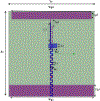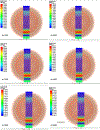Numerical Modeling and Computer Simulation of a Meander Line Antenna for Alzheimer's Disease Treatment, a Feasibility Study
- PMID: 36945328
- PMCID: PMC10026125
- DOI: 10.4236/jbm.2023.112013
Numerical Modeling and Computer Simulation of a Meander Line Antenna for Alzheimer's Disease Treatment, a Feasibility Study
Abstract
Alzheimer's disease (AD) is a brain disorder that eventually causes memory loss and the ability to perform simple cognitive functions; research efforts within pharmaceuticals and other medical treatments have minimal impact on the disease. Our preliminary biological studies showed that Repeated Electromagnetic Field Stimulation (REFMS) applying an EM frequency of 64 MHz and a specific absorption rate (SAR) of 0.4 - 0.9 W/kg decrease the level of amyloid-β peptides (Aβ), which is the most likely etiology of AD. This study emphasizes uniform E/H field and SAR distribution with adequate penetration depth penetration through multiple human head layers driven with low input power for safety treatments. In this work, we performed numerical modeling and computer simulations of a portable Meander Line antenna (MLA) to achieve the required EMF parameters to treat AD. The MLA device features a low cost, small size, wide bandwidth, and the ability to integrate into a portable system. This study utilized a High-Frequency Simulation System (HFSS) in the design of the MLA with the desired characteristics suited for AD treatment in humans. The team designed a 24-turn antenna with a 60 cm length and 25 cm width and achieved the required resonant frequency of 64 MHz. Here we used two numerical human head phantoms to test the antenna, the MIDA and spherical head phantom with six and seven tissue layers, respectively. The antenna was fed from a 50-Watt input source to obtain the SAR of 0.6 W/kg requirement in the center of the simulated brain tissue layer. We found that the E/H field and SAR distribution produced was not homogeneous; there were areas of high SAR values close to the antenna transmitter, also areas of low SAR value far away from the antenna. This paper details the antenna parameters, the scattering parameters response, the efficiency response, and the E and H field distribution; we presented the computer simulation results and discussed future work for a practical model.
Keywords: Alzheimer’s Disease; EMF Linearity; Field Distribution; HFSS; Meander Line Antenna; SAR.
Conflict of interest statement
Conflicts of Interest The authors declare no conflicts of interest regarding the publication of this paper.
Figures





References
-
- Dytioco Santos JP, Fereidoony F, Hedayati M and Wang YE (2020) High Efficiency Bandwidth VHF Electrically Small Antennas through Direct Antenna Modulation. IEEE Transactions on Microwave Theory and Techniques, 68, 5029–5041, 10.1109/TMTT.2020.3016381 - DOI
-
- Rodriguez V (2018) On Selecting the Most Suitable Range for Antenna Measurements in the VHF-UHF Range. 2018 IEEE Conference on Antenna Measurements & Applications (CAMA), Sweden, 3–6 September 2018, 1–3. 10.1109/CAMA.2018.8530667 - DOI
-
- Perez FP, Rahmani M, Emberson J, Weber M, Morisaki J, Amran F, Bakri S, Halim A, Dsouza A, Yusuff NM, Farhan A, Maulucci J and Rizkalla M (2022) EMF Antenna Exposure on a Multilayer Human Head Simulation for Alzheimer Disease Treatments. Journal of Biomedical Science and Engineering, 15, 129–139. 10.4236/jbise.2022.155013 - DOI - PMC - PubMed
-
- Choi J and Sarabandi K (2016) HF/VHF Antenna Characterization from Very-near-Field Measurements over Arbitrary Closed Surfaces. 2016 United States National Committee of URSI National Radio Science Meeting (USNC-URSI NRSM), Boulder, 6–9 January 2016, 1–2. 10.1109/USNC-URSI-NRSM.2016.7436254 - DOI
Grants and funding
LinkOut - more resources
Full Text Sources
Miscellaneous
